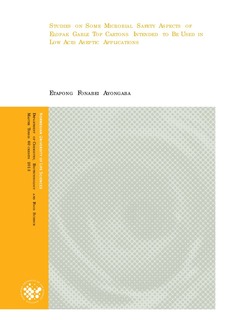| dc.contributor.author | Ayongaba Etapong, Fonabei | |
| dc.date.accessioned | 2014-02-19T10:50:36Z | |
| dc.date.copyright | 2012 | |
| dc.date.issued | 2014-02-19 | |
| dc.identifier.uri | http://hdl.handle.net/11250/186553 | |
| dc.description.abstract | In developing a low acid aseptic system, much attention is given to the efficiency of the sterilization system and the microbiological quality of the packaging materials. Considering that low acid foods are very vulnerable if contaminated by a variety of microorganisms, the microbiological quality of the packaging material (carton) is considered a critical factor in determining the success of the whole process.
This thesis ascertain critical microbiological aspects of the Elopak gable top carton which will be used for filling low acid aseptic liquid products by the low acid aseptic filling machine currently under development at Elopak AS. Due to the unrelated nature of the different topics studied in this thesis, the thesis is detailed in four different sections;
Section one is based on investigations that were carried out during the optimization phase of the sterilization system. It investigates structures in the carton that contributes in making decontamination in the corners very hard to achieve.
The nature of the corners was determined by electron microscopy. Attention was also paid to how spores were distributed in the corners. A model (sterilization rig) of the newly developed sterilization system was used to evaluate kill rate in three types of cartons with different corner topology. Comparative analysis by Electron microscopy was also done between the corners of the Elopak gable top aseptic carton and corners in cartons from a company with a commercially functional low acid aseptic processing system, carrying out carton sterilization in a similar way to that used by Elopak.
The investigation showed that the Elopak gable top carton had numerous structures of different morphologies in the corners. The cartons from the competitor company had fewer structures which were far wider than those present in the Elopak carton. Kill rates in cartons with no structures in the corners were higher than in cartons with structures in the corner.
This section concluded that the structures in the Elopak gable top carton were partially responsible for the low decontamination observed in the corners, and smoothening of these corners would increase decontamination in them. Comparative analysis revealed that the competitor company avoided low decontamination at the corners by maneuvering corner topology in their cartons.
The next sections pay more attention to microbiology related aspects of the Elopak gable top carton.
In section two, the type of spore formers found in paperboard and those contaminating carton blanks after production were identified. Spore formers in dust samples in the production premises were also of interest in this section.
Paperboard and dust samples were homogenized and plated on agar plates. Flat blanks were exposed in blank storage halls at the convertor plant, and contact plates used to grow the contaminating spores on these flat blanks. Some colonies from the different samples were selected based on unique colony morphology, and their 16s rRNA genes were sequenced to identify them.
In this study, the bacteria isolated from paperboard and those identified as contaminants on flat carton blanks were of Bacillus spp. Clostridium spp. were also found to be present in dust samples. 16s rRNA gene sequencing hinted that Clostridium botulinum might be present in the dust samples.
The presence of Clostridium botulinum, a lethal food pathogen which will readily grow in low acid food foods under favorable conditions was speculated in dust samples within the Elopak converter plant by results from section 2. This necessitated the need for a proper investigation of the incidence of Clostridium botulinum in dust samples. Section 3 therefore investigated the presence of botulinum neurotoxin genes in the dust samples from which 16s rRNA gene sequencing gave hints of the presence of Clostridium botulinum.
The dust samples were inoculated in nutrient broth to enrich for Clostridium botulinum. Primer sets specifically designed to target and amplify botulinum neurotoxin genes where used in a real-time polymerase chain reaction to detect the presence of these genes in the enriched dust samples.
Clostridium botulinum serotype B and F were found to be present in dust samples from the boxing area and rail in front of the entrance hall respectively.
In the fourth section, the risk of potentially harmful bacteria in paperboard crossing through tiny holes in the layers laminating the paperboard to contaminate products stored in the carton was studied.
Holes about four times bigger than the micro holes found in the laminating layers of the gable top carton were artificially made in the layers laminating paperboard in the gable top carton blanks. The perforated carton blanks were then sterilized and filled with aseptic validation medium (AVM) using the new low acid aseptic filling machine. The filled cartons were incubated at 30 0C for 5 weeks.
No growth in medium was observed after incubation, suggesting that bacteria might not be able to migrate through the micro holes present on the laminating layers, or that more time would be needed for bacteria to pass through them. | no_NO |
| dc.description.sponsorship | Elopak AS | no_NO |
| dc.language.iso | eng | no_NO |
| dc.publisher | Norwegian University of Life Sciences, Ås | |
| dc.title | Studies on some microbial safety aspects of Elopak gable top cartons intended to be used in low acid aspetic applications | no_NO |
| dc.type | Master thesis | no_NO |
| dc.subject.nsi | VDP::Technology: 500::Food science and technology: 600 | no_NO |
| dc.subject.nsi | VDP::Mathematics and natural science: 400::Basic biosciences: 470::General microbiology: 472 | no_NO |
| dc.description.embargo | 2017-12-15 | |
| dc.source.pagenumber | 103 | no_NO |
